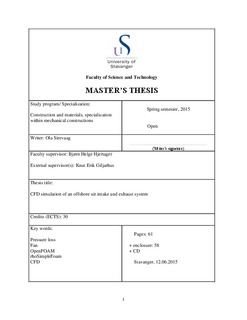| dc.description.abstract | The main purpose is to investigate whether the exhaust gases from an offshore turbine can be rerouted to heat the air entering the turbine system, thus keeping air humidity concentration above acceptable levels. To ensure this, temperature of the incoming airflow must be above 4,5 degrees Celsius. Currently the exhaust is vented out to the atmosphere and an electrical anti-icing system is used to heat the air intake. The objective of this thesis is therefore to make a CFD model in OpenFOAM to simulate the two proposed pipe designs that will connect the exhaust to the air intake. By evaluating the results from the simulation, a conclusion shall be drawn to whether the new pipe layout is a viable solution and can replace the current anti-icing system, thus saving money and electrical power. A critical part of the new system is the existing exhaust fan, which will be used to drive the exhaust gases towards the front of the air intake. With the provided fan performance curve, time has been spent to find the appropriate boundary condition that will simulate the fan behavior, and its effect on the flow conditions as accurately as possible. The same goes for the exhaust heat dissipation through the pipe wall, and to the surrounding environment. Operation conditions include cross winds up to 10m/s and atmospheric temperatures down to negative 10 degrees Celsius. To incorporate this into the CFD model, appropriate manual calculations had to be performed beforehand to find the local heat transfer coefficient. The system size and air flow velocities, results in a relatively large mesh model. Therefore, to ensure as low computational execution times as possible, multiple meshing settings are explored to ensure as few excess cells as possible. Temperature and flow results from the simulations shows that fan performance and both pipe designs are more than adequate to ensure turbine operation. Mesh quality is also verified using the yPlus value. However, in the attempt to confirm the simulated pressure loss with the Bernoulli equation, the loss coefficient found in reference literature does not produce an accurate result. In addition, it is found that the OpenFOAM documentation does not specify the unit of measurement used in the fan curve specification. Without being able to determine whether the fan curve should be defined using mass flow or volumetric flow, the final CFD models have a degree of inaccuracy regarding the fan behavior. Nevertheless, simulation results have a high enough tolerance, relative to system requirements, that the fan can be cleared suitable for operation. | nb_NO |

